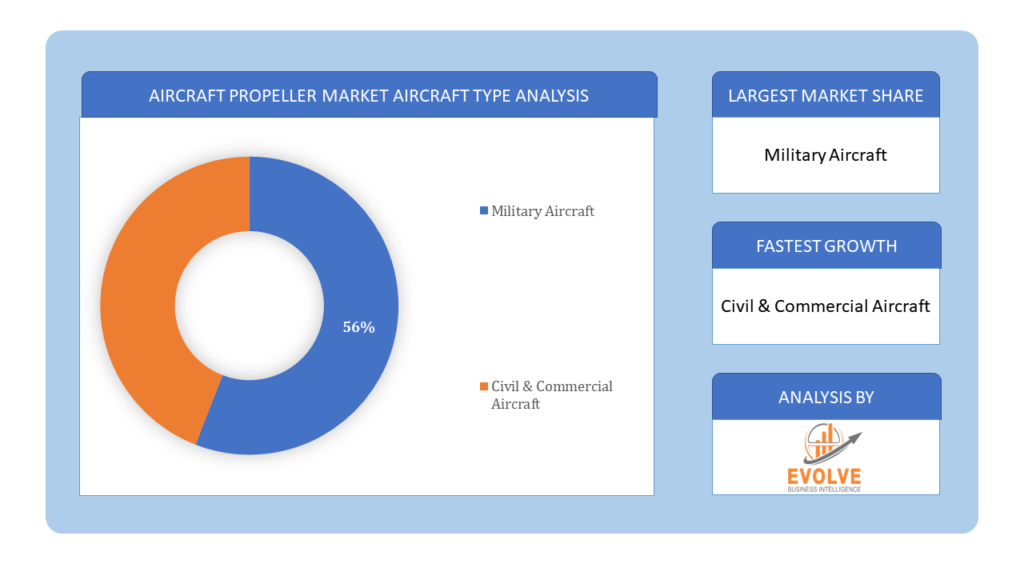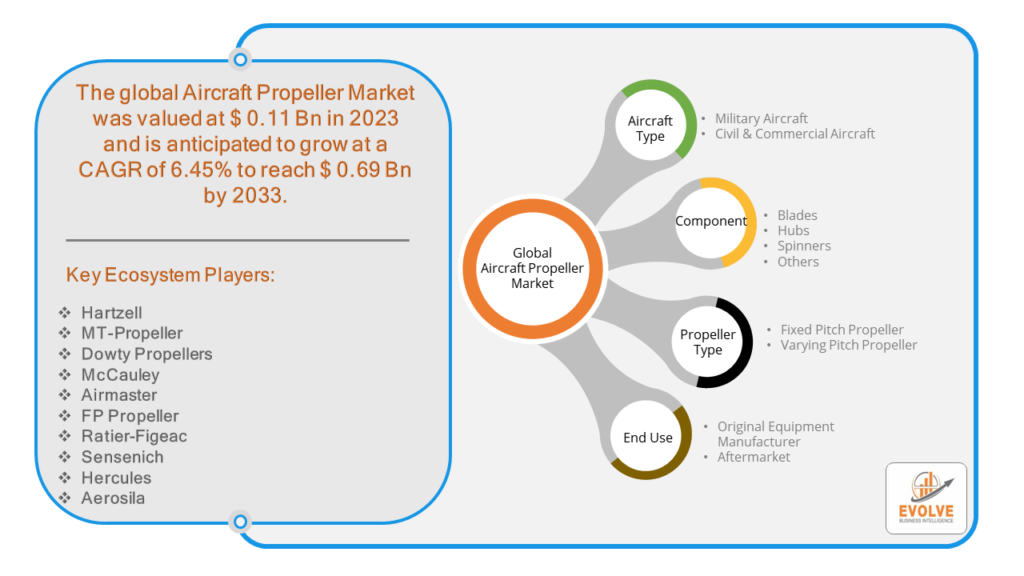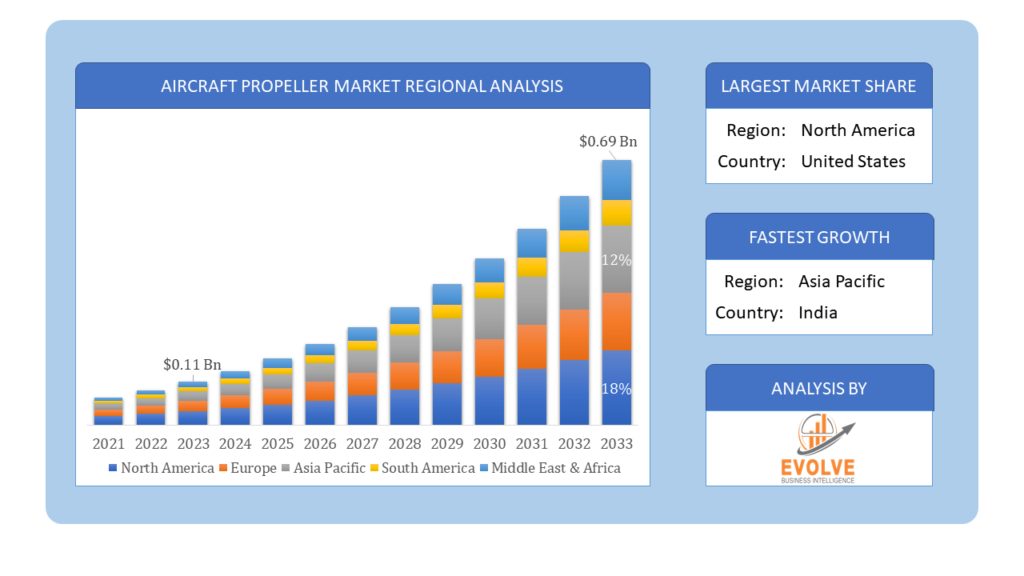Aircraft Propeller Market Overview
The Aircraft Propeller Market Size is expected to reach USD 0.69 Billion by 2033. The Aircraft Propeller Market industry size accounted for USD 0.11 Billion in 2023 and is expected to expand at a compound annual growth rate (CAGR) of 6.45% from 2023 to 2033. The Aircraft Propeller Market refers to the industry involved in the design, manufacturing, and distribution of propellers used in aircraft. Propellers play a crucial role in aviation, especially in aircraft powered by piston engines or turboprop engines. These propellers are responsible for generating thrust by converting engine power into rotational motion, thereby propelling the aircraft forward. The market includes various types of propellers designed for different aircraft sizes, performance requirements, and environmental conditions. Factors influencing the market include technological advancements, aircraft production rates, fuel efficiency demands, and regulatory standards.
The market is expected to grow steadily in the coming years, driven by factors such as the increasing demand for fuel-efficient aircraft, the rising popularity of unmanned aerial vehicles (UAVs), and the growing investment in general aviation.
Global Aircraft Propeller Market Synopsis
The COVID-19 pandemic had a significant impact on the Aircraft Propeller Market. The pandemic led to a drastic decrease in air travel worldwide due to travel restrictions, lockdowns, and reduced passenger demand. This directly affected the demand for new aircraft and, consequently, for aircraft propellers. Lockdowns and restrictions disrupted global supply chains, affecting the manufacturing and delivery of aircraft components, including propellers. Production delays and shortages were common. With passenger flights reduced, there was a shift towards cargo operations to meet essential goods demand. Aircraft used for cargo often differ in propeller requirements compared to passenger aircraft, influencing market dynamics. As air travel began to recover in some regions, the market for propellers also showed signs of recovery, albeit unevenly across different segments and regions.
Aircraft Propeller Market Dynamics
The major factors that have impacted the growth of Aircraft Propeller Market are as follows:
Drivers:
Ø Rising Demand for Turboprop Aircraft
Turboprop aircraft, which rely on propellers for propulsion, are favored for short-haul flights due to their fuel efficiency and lower operational costs compared to jet aircraft. The demand for turboprops drives the need for advanced and efficient propeller systems. Continuous advancements in materials, design, and manufacturing techniques enhance propeller efficiency, reliability, and durability. Innovations such as composite materials and aerodynamic improvements contribute to market growth. Adoption of electric and hybrid-electric propulsion systems in aircraft, including propeller-driven models, represents a growing segment with potential for significant market expansion in the future.
Restraint:
- Perception of Competition from jet engines
Jet engines are generally more fuel-efficient at high altitudes and over long distances compared to turboprop engines that use propellers. This makes them the preferred choice for large commercial airplanes traveling long routes. While advancements are being made, propellers inherently have limitations on how efficient they can be compared to jet engines, especially at high speeds. The growing demand for faster travel times, particularly for long-haul flights, can favor jet-powered airplanes over propeller-driven ones.
Opportunity:
⮚ Emerging Markets for Regional Connectivity
There is a growing demand for regional connectivity in emerging markets and remote areas, where propeller-driven aircraft are often more economical and practical than jet-powered alternatives. This creates opportunities for manufacturers to supply efficient and reliable propeller systems tailored to regional aviation needs. As airlines and operators seek to enhance fleet efficiency and comply with environmental regulations, there is a growing market for retrofitting older aircraft with modern propeller systems. This includes upgrading to more fuel-efficient designs and integrating advanced technologies for improved performance.
Aircraft Propeller Market Segment Overview
By Aircraft Type
 Based on Aircraft Type, the market is segmented based on Military Aircraft and Civil & Commercial Aircraft. Civil aircraft propeller systems are designed and used for civilian applications, including commercial airliners, general aviation aircraft, regional aircraft, and business jets. They are typically optimized for efficiency, reliability, and passenger comfort. They are engineered to meet stringent safety standards and undergo thorough certification processes. They are designed for extended service life, ease of maintenance, and operational reliability.
Based on Aircraft Type, the market is segmented based on Military Aircraft and Civil & Commercial Aircraft. Civil aircraft propeller systems are designed and used for civilian applications, including commercial airliners, general aviation aircraft, regional aircraft, and business jets. They are typically optimized for efficiency, reliability, and passenger comfort. They are engineered to meet stringent safety standards and undergo thorough certification processes. They are designed for extended service life, ease of maintenance, and operational reliability.
By Component
Based on Component, the market segment has been divided into the Blades, Hubs, Spinners and Others. The Blades segment dominant the market. A blade is a vital component of an aircraft propeller system. It is the airfoil-shaped section that generates lift and thrust as it rotates through the air. It is made of lightweight materials, such as aluminum, composite materials, or wood, which depends on the type of aircraft and its operating conditions. It incorporates features, such as the blade airfoil shape, twist distribution along the length, and the angle of attack. It is usually mounted on the hub and secured with bolts or other fasteners.
By Propeller Type
Based on Propeller Type, the market segment has been divided into the Fixed Pitch Propeller and Varying Pitch Propeller. Fixed pitch propellers have blades with a fixed angle or pitch that cannot be adjusted during flight. They are commonly found in smaller general aviation aircraft and some low-speed applications. They offer simplicity, lower weight, and lower manufacturing and maintenance costs.
By End Use
Based on End Use, the market segment has been divided into the Original Equipment Manufacturer and Aftermarket. The aftermarket use of aircraft propeller systems involves the replacement or upgrade of propeller systems on aircraft that are already in service. Aftermarket propeller replacement ensures the continued airworthiness of the aircraft by enhancing aircraft capabilities and operational efficiency.
Global Aircraft Propeller Market Regional Analysis
Based on region, the global Aircraft Propeller Market has been divided into North America, Europe, Asia-Pacific, the Middle East & Africa, and Latin America. North America is projected to dominate the use of the Aircraft Propeller Market followed by the Asia-Pacific and Europe regions.
 Aircraft Propeller North America Market
Aircraft Propeller North America Market
North America holds a dominant position in the Aircraft Propeller Market. This region is a significant market for aircraft propellers, driven by a large fleet of general aviation and regional aircraft. Technological advancements and the presence of major aircraft manufacturers and suppliers contribute to market growth. The U.S. particularly leads in defense applications and general aviation sectors.
Aircraft Propeller Asia-Pacific Market
The Asia-Pacific region has indeed emerged as the fastest-growing market for the Aircraft Propeller Market industry. Rapid economic growth, expanding air travel demand, and infrastructure development in countries like China and India contribute to growth in this region. The focus on regional connectivity and increasing investments in aviation infrastructure present opportunities for propeller manufacturers.
Competitive Landscape
The global Aircraft Propeller Market is highly competitive, with numerous players offering a wide range of software Components. The competitive landscape is characterized by the presence of established companies, as well as emerging startups and niche players. To increase their market position and attract a wide consumer base, the businesses are employing various strategies, such as product launches, and strategic alliances.
Prominent Players:
- Hartzell
- MT-Propeller
- Dowty Propellers
- McCauley
- Airmaster
- FP Propeller
- Ratier-Figeac
- Sensenich
- Hercules
- Aerosila
Key Development
In July 2021, Hartzell Propeller acquired Tanis Aircraft Products’, a leading manufacturer of engine preheat systems, to expand their heating products options.
In July 2020, Dowty Propellers collaborated with Haydale Graphene Industries plc (Haydale) to develop graphene and nano material-enhanced products.
Scope of the Report
Global Aircraft Propeller Market, by Aircraft Type
- Military Aircraft
- Civil & Commercial Aircraft
Global Aircraft Propeller Market, by Component
- Blades
- Hubs
- Spinners
- Others
Global Aircraft Propeller Market, by Propeller Type
- Fixed Pitch Propeller
- Varying Pitch Propeller
Global Aircraft Propeller Market, by End Use
- Original Equipment Manufacturer
- Aftermarket
Global Aircraft Propeller Market, by Region
- North America
- US
- Canada
- Mexico
- Europe
- UK
- Germany
- France
- Italy
- Spain
- Benelux
- Nordic
- Rest of Europe
- Asia Pacific
- China
- Japan
- South Korea
- Indonesia
- Austalia
- Malaysia
- India
- Rest of Asia Pacific
- South America
- Brazil
- Argentina
- Rest of South America
- Middle East & Africa
- Saudi Arabia
- UAE
- Egypt
- South Africa
- Rest of Middle East & Africa
| Parameters | Indicators |
|---|---|
| Market Size | 2033: $0.69 Billion/strong> |
| CAGR | 6.45% CAGR (2023-2033) |
| Base year | 2022 |
| Forecast Period | 2023-2033 |
| Historical Data | 2021 |
| Report Coverage | Revenue Forecast, Competitive Landscape, Growth Factors, and Trends |
| Key Segmentations | Aircraft Type, Component, Propeller Type, End Use |
| Geographies Covered | North America, Europe, Asia-Pacific, Latin America, Middle East, Africa |
| Key Vendors | Hartzell, MT-Propeller, Dowty Propellers, McCauley, Airmaster, FP Propeller, Ratier-Figeac, Sensenich, Hercules and Aerosila |
| Key Market Opportunities | • Emerging Markets for Regional Connectivity • Retrofit and Upgrade Market |
| Key Market Drivers | • Rising Demand for Turboprop Aircraft • Technological Advancements |
REPORT CONTENT BRIEF:
- High-level analysis of the current and future Aircraft Propeller Market trends and opportunities
- Detailed analysis of current market drivers, restraining factors, and opportunities in the future
- Aircraft Propeller Market historical market size for the year 2021, and forecast from 2023 to 2033
- Aircraft Propeller Market share analysis at each product level
- Competitor analysis with detailed insight into its product segment, Government & Defense strength, and strategies adopted.
- Identifies key strategies adopted including product launches and developments, mergers and acquisitions, joint ventures, collaborations, and partnerships as well as funding taken and investment done, among others.
- To identify and understand the various factors involved in the global Aircraft Propeller Market affected by the pandemic
- To provide a detailed insight into the major companies operating in the market. The profiling will include the Government & Defense health of the company’s past 2-3 years with segmental and regional revenue breakup, product offering, recent developments, SWOT analysis, and key strategies.







